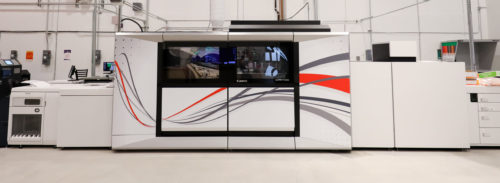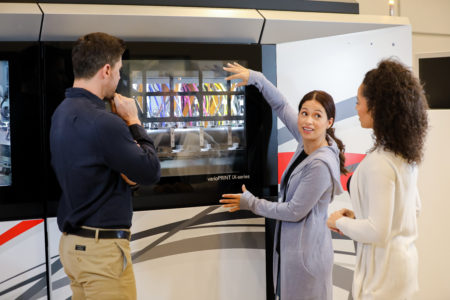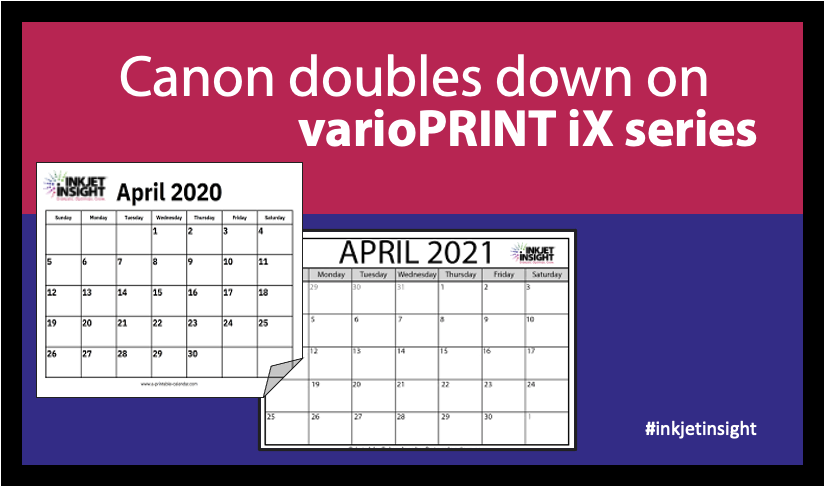Sponsored Content
In April 2020 I wrote that Canon Solutions America had doubled down on commercial print with the launch of the Canon varioPRINT iX-series. At that time, the VarioPRINT iX3200 and iX2100 were additions to a sheet-fed inkjet portfolio that included the iSeries and the iSeries+ lines. In 2021, Canon doubled down on the iX-series as their flagship sheet-fed inkjet press. Canon is no longer producing the other iSeries models but does continue to support them and to sell refurbished presses due to their wide install base and popularity in less quality intensive application segments.
The varioPPRINT iX3200 and iX2100, are intended for general commercial printers, direct mailers and book printers who require high image quality on a wide media range and flexibility to run mixed media jobs at full speed.

Press Overview
The iX3200 runs at 320 A4 ipm (images per minute) and produces up to 10 million impressions per month while the iX2100 runs at 210 ipm and produces up to 7 million impressions per month. Each runs at its top speed on all currently evaluated and supported media and coverage levels. There are no physical differences between the models and upgrade from one to the other is as simple as a license fee. From here I will refer to both models as the iX-series.
The iX-series presses use Kyocera’s second generation 1200 dpi printheads. Head control includes cooling the ink to manage temperature in and around the print head to optimize performance and drop formation. Each press uses 3 Kyocera KJ4B 1200 dpi print heads per color, that’s 12 heads in total for CMYK. The heads jet 2 distinct drop sizes (2 and 5 picoliters) producing 3 gray levels. The higher resolution printheads offer improved image quality over previous models and the smaller droplets fired are also easier to dry.
The iQuarius inks for the iX-series are developed and produced in house by Canon. Optimal performance requires the use of their conditioning liquid, ColorGrip, but the fluid is placed only where needed rather than on the entire page which provides a cost and paper handling advantage over flood coated priming systems. Canon’s iQuarius drying and fixation system uses a 2 step drying process that delivers consistently flat prints which I covered in more detail previously. Inks, ColorGrip and 2 step drying combine to enable wide media compatibility of 60 – 350gsm uncoated (40# text – 130# cover) and 90 – 350gsm for offset coated (60# text – 130# cover) including gloss finishes.
The presses also distinguish themselves with a standard XL-sized paper input module, which holds sheets up to 350 x 508mm. They also support instant media switching with a printer input module comprised of 4 trays holding up to 4,500 sheets (with the ability to connect multiple PIMs for max of 13,500 sheets in 12 trays)
The iX-series presses were also some of the first to offer automated inline quality control routines to ensure consistent quality by detecting jet outs and evaluating past head performance to see if jet is fully out or experiencing intermittent issues. The iX-series also introduced major changes to paper transport and sheet control using a perforated stainless-steel belt and vacuum suction.

Not Really One Year Later
The iX-series was launched in April of 2020 but wasn’t available in market until July. With initial sales limited to Europe, the presses have only been available in North America for a little over 6 months. According to Ed Jansen, Vice President PPS Marketing with Canon Solutions America, Inc., the company sold out of 2020 U.S. inventory in record time. “Canon was successful in reaching our target audience with over half of installations occurring at commercial print shops and the remaining installs split between book printers, direct mail printers, and corporate in-plants,” said Jansen.
Jansen also shared that the iX-series is opening up new customer relationships for Canon with 30% of installs going to net new Canon customers and the remaining going to the loyal Canon customer base. Jansen said, “This press continues to win over business from previous toner users with over half of iX-series installs being toner replacements. We are also seeing our customers move applications that were previously done on multiple presses, and necessitated multiple steps on offset and toner combinations, to the iX-series for one white-paper-in, finished-product-out solution.”
The distribution of customers is not a complete surprise as Canon made a push to expand beyond their initial segment targets through application-focused solutions and flexible pricing models. “We launched the Book iX Solution which combines Canon’s Conveyance Workflow and C.P Bourg finishing to make one automated book solution – data in and finished book out,” said Jansen. “We also offer a variety of payment plans that can allow customers to tailor their payment plans to find the best option for their business. These customized plans can help customers either lower their cost to win more business, or expand their margin on jobs to earn more profit.“ In the best of worlds, customers using the iX-series will be doing both.

